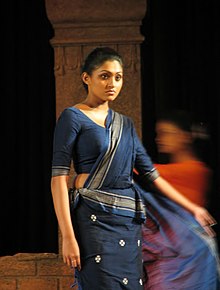Sinhalese people (Sinhala: සිංහල ජනතාව, romanized: Sinhala Janathāva), historically known as Hela people (Sinhala: හෙළ) are an Indo-Aryan ethnic group of the island of Sri Lanka.[11] They constitute about 75% of the Sri Lankan population and number greater than 16.2 million.[1][2] The Sinhalese identity is based on language, cultural heritage and nationality.
The Sinhalese people speak Sinhala, an insular Indo-Aryan language, and are predominantly Theravada Buddhists,[12] although a minority of Sinhalese follow branches of Christianity and other religions. Since 1815, they were broadly divided into two respective groups:
The ‘Up-country Sinhalese’ in the central mountainous regions, and the ‘Low-country Sinhalese’ in the coastal regions; although both groups speak the same language, they are distinguished as they observe different cultural customs.[13][14] According to the 5th-century epic poem Mahavamsa and the Dipavamsa, a 3rd–5th century treatise written in Pali by Buddhist monks of the Anuradhapura Maha Viharaya in Sri Lanka, the Sinhalese descend from the Indo-Aryan settlers who came to the island in 543 BCE from Sinhapura, in India, led by Prince Vijaya.[15]
Part 2
Culture
Sinhalese culture is a unique one dating as far back as 2600 years and has been nourished by Theravada Buddhism. Its main domains are sculpture, fine arts, literature, dancing, poetry and a wide variety of folk beliefs and rituals traditionally. Ancient Sinhala stone sculpture and inscriptions are known worldwide and is a main foreign attraction in modern tourism. Sigirirya is famous for its frescoes.
Folk poems were sung by workers to accompany their work and narrate the story of their lives. Ideally these poems consisted of four lines and, in the composition of these poems, special attention had been paid to the rhyming patterns. Buddhist festivals are dotted by unique music using traditionally Sinhalese instruments. More ancient rituals like tovils (devil exorcism) continue to enthral audiences today and often praised and admired the good and the power of Buddha and gods in order to exorcise the demons.
Folklore and national mythology
According to the Mahavamsa, the Sinhalese are descended from the exiled Prince Vijaya and his party of seven hundred followers who arrived on the island in 543 BCE.
Vijaya and his followers were said to have arrived in Sri Lanka after being exiled from the city of Sinhapura in Bengal. The modern Sinhalese people were found genetically to be most closely related to the people of North-East India (Bengal).[57][58] It is thought throughout Sri Lanka’s history, since the founding of the Sinhalese in the 5th century BC that an influx of Indians from North India came to the island
This is further supported from Sinhala being part of the Indo-Aryan language group.[59][better source needed]
Traditionally during recreation the Sinhalese wear a sarong (sarama in Sinhala). Men may wear a long-sleeved shirt with a sarong. Clothing varies by region for women.
Low country Sinhalese women wear a white Long sleeved jacket, and a tight wrap around skirt, which usually is embedded with a floral or pattern design. As for the up country Sinhalese, women wear a similar outfit, but with a puffed up shoulder jacket, and a tucked in frill that lines the top of the skirt (Reda and Hatte in Sinhala).
Traditionally, high caste Kandyan women wear a Kandyan style sari, which is similar to the Maharashtrian sari, with the drape but with a frill lining the bottom half and sometimes puffed up sleeves. It’s also called an Osariya.
The low country high caste women wear a South Indian style saree. Within the more populated areas, Sinhalese men also wear Western-style clothing — wearing suits while the women wear skirts and blouses.
For formal and ceremonial occasions women wear the traditional Kandyan (Osariya) style, which consists of a full blouse which covers the midriff completely, and is partially tucked in at the front. However, modern intermingling of styles has led to most wearers baring the midriff. The Kandyan style is considered as the national dress of Sinhalese women.
In many occasions and functions, even the saree plays an important role in women’s clothing and has become the de facto clothing for female office workers especially in government sector. An example of its use is the uniform of air hostesses of Sri Lankan Airlines.[42]
for more information about ART and Education
please visit the source



Wow, fantastic blog layout! How lengthy have you been blogging for?
you made running a blog look easy. The entire look of your
web site is fantastic, as well as the content! You can see similar here e-commerce
Wow, wonderful weblog layout! How long have you ever been blogging for?
you make running a blog look easy. The overall glance
of your site is magnificent, as neatly as the content material!
You can see similar here najlepszy sklep
Thank you for your sharing. I am worried that I lack creative ideas. It is your article that makes me full of hope. Thank you. But, I have a question, can you help me?